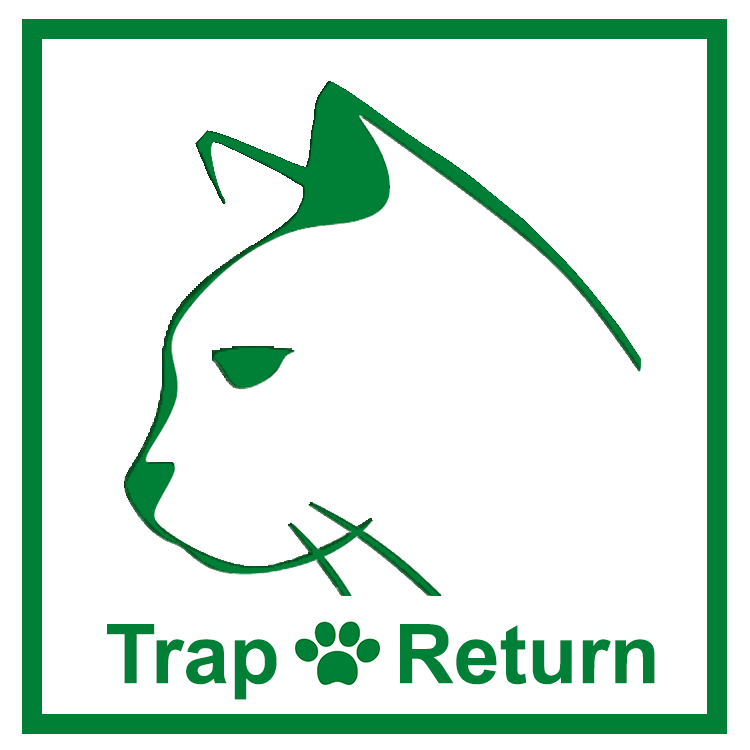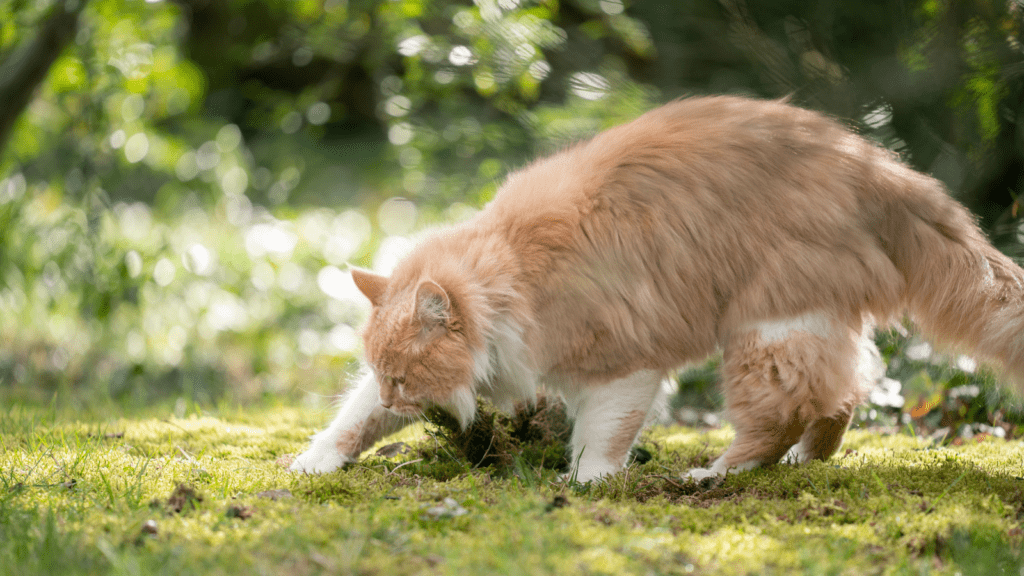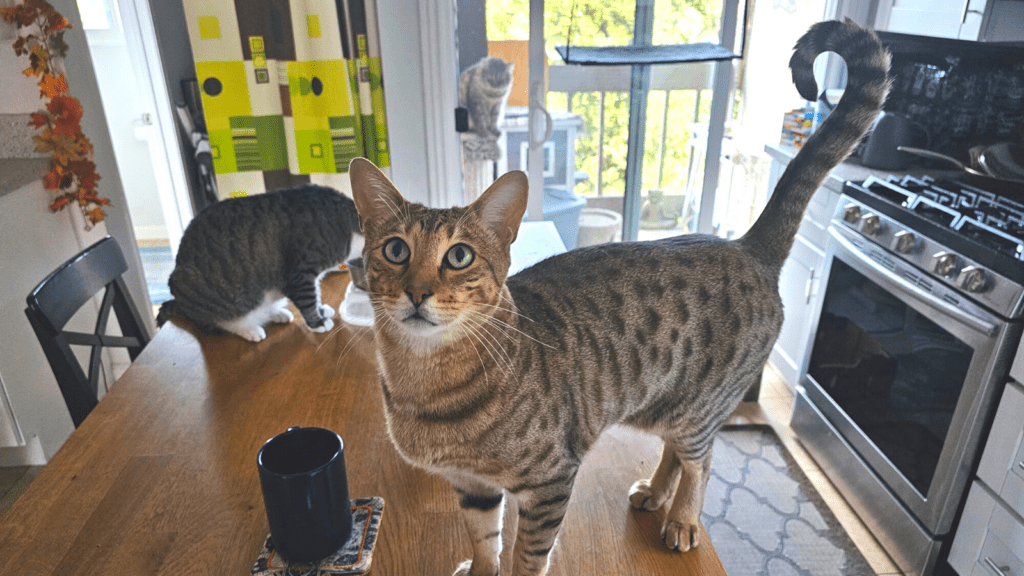
Cat Tail Language
Do you ever wish you could speak fluent “cat tail language”? While we may not be able to meow our way through conversations, we can certainly understand our feline friends better by learning the secret language of cat tails. Let’s dive into the wonderful world of tail talk and unlock the mysteries of feline communication!
Tail Talk: Decoding Common Cat Tail Positions
Cats are enigmatic creatures, but did you know that their tails can reveal a wealth of information about their emotions and intentions? Just like humans use facial expressions and body language, cats have their own way of conveying their feelings through tail movements. So, let’s unravel the cat-shaped silhouette and explore the various cat tail signals.
A cat’s tail can be a telltale sign of their mood. Understanding a cat’s mood can also be helpful in interpreting their tail language. Here are some examples of cat tail language:
- A tail held high is a friendly greeting, indicating a happy tail ready to socialize.
- A lowered tail may signal fear, uncertainty, or potential aggression.
- A tightly wrapped tail around their body might mean they’re feeling a bit wary, uneasy, or even frazzled.
Observing not just their tail movements but also their entire body language is a key factor in understanding cat tail language. It’s important to consider other clues in their environment to get the full picture of your cat’s emotions and to understand cat tail language more effectively.
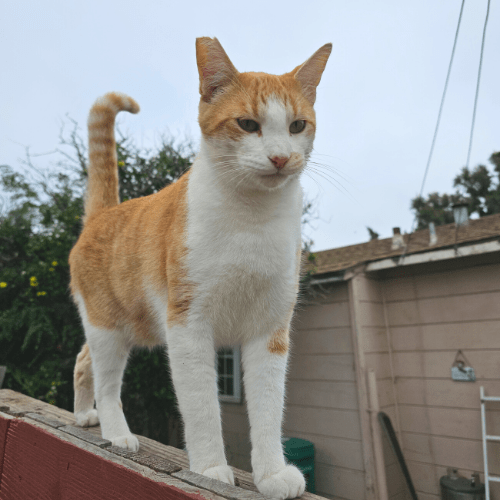
Cats use their tails to express their emotions. It is also a way for them to communicate with other cats. An arched back with a puffed tail shows a defensive reaction, while a tail wrapped around another cat is a sign of affection and companionship.
The Question Mark: Playful and Curious Tails
What’s that? A cat’s tail shaped like a question mark? No, your eyes aren’t playing tricks on you! This curious tail formation symbolizes a sense of fun and inquisitiveness. A sly wag of a cat’s tail indicates that the cat is checking out the scene and sniffing out something intriguing. It’s like they’re asking, “What’s that? Can I play, too?”
When a cat’s tail is pointing up and doing a little jig, the cat feels quite inquisitive. If the tail is curled tightly, it can indicate a different emotion or state of mind. So, next time you see that question mark-shaped tail, you know your feline friend is in a playful mood, ready to engage in some fun activities!
Swishing and Flicking: Signs of Fear or Playfulness
Swishing and flicking tails can be a bit of a puzzle to decipher, as they can signal both fear and playfulness. Observing your cat’s body language and environment is the key to solving this riddle.
For example, when a cat swishes its tail slowly from side to side, it appears the kitty is intently focused on something that has caught their eye in their cat’s environment, like a toy, another furry friend, or another cat beyond the window. These cat’s tail movements, or as some might call it, “cats wag,” can be a clear indication that they are about to pounce! So, what are they trying to tell us with these tail movements?
To better understand cat tail language, when their tail is swishing back and forth, look at other signs they are giving off. If they seem tense and their ears are flat, the cat may be feeling scared. But if their ears and body are upright, it could be time for some fun.
Rapid Thrashing: Annoyance and Irritation
Have you ever witnessed a furious tail swishing from your cat? That’s just the kitty’s way of saying, “I’m not amused.” A mildly peeved kitty might thump or twirl the tip of its tail. Paying attention to these warning signs is important as they can reflect your cat’s feelings of annoyance or irritation.
If you spot your cat with the following behaviors, it’s best to give your kitty some personal space because your cat may be ready to pounce.
- Dilated pupils
- Ears flattened against their head
- Hissing
- Thrashing tail
After all, we all need a little “me time” now and then, and our feline friends are no exception!
Quivering Tails: Excitement and Anticipation
A quivering tail in cats can mean they’re excited to see you, curious about something, or just keeping a watchful eye. It could also be cat tail language as a sign of love and affection. But there’s one quivering-tail scenario that might leave you puzzled: when a cat quivers its tail while holding it straight up and backing up against a vertical surface. This is a sign of urine marking and may be a symptom of a medical issue or simply a territorial behavior from other cats.
Whether your cat’s tail is quivering with excitement during playtime or simply marking their territory, understanding these subtle signals can enhance communication with your feline friend.
Affectionate Gestures: Wrapped and Hooked Tails
Cats may not always be forthcoming with their emotions, but your cat’s tail position can provide some heartwarming insights. A tail wrapped around a human or another cat is a sweet sign of affection and friendship. It’s like a feline hug, saying, “Hey, let’s be friends!”
Cats also exchange pleasantries by curling their tails around people and giving tail-fives to other cats. So, the next time your cat wraps their tail around you or their best friend, consider it an honor, as they’re showing you the feline body language for love and trust.
Tail Defense: Puffed Up and Wrapped Around the Body
Cats puff up their tails or wrap them around their bodies when they’re feeling threatened or defensive. It’s their way of saying, “Please, give me some space.” This defensive reaction can happen when cats feel threatened by other animals, loud noises, or even houseguests.
To better understand your cat’s emotions in these situations, observe their entire body language, not just their tail movements. A puffed-up tail with an arched back indicates a defensive reaction or an aggressive cat. On the other hand, a tail wrapped tightly around their body could mean they’re feeling scared, in pain, or experiencing discomfort.
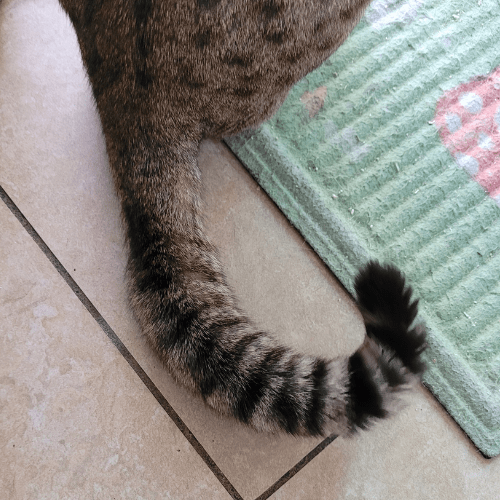
If your cat remains in a tight ball for more than a few days, it’s time to make that vet appointment. After all, ensuring your cat’s well-being is paramount, and being attuned to their tail language can help you spot potential issues early on.
Reading the Subtle Signs: Tail Tip Movements
Even the subtlest tail-tip movements can reveal a cat’s mood. A twitch of the tail-end might indicate curiosity, playfulness, or mild annoyance. When your cat’s tail starts twitching, a careful analysis of the situation can help decipher what they’re feeling.
A relaxed cat with a “low-key or laid-back” tail position is simply enjoying some chill time. Full-on tail wagging is a sign of active playfulness. So, whether your cat is snoozing in the sun or intently watching the birds outside, understanding these subtle tail-tip movements can help you stay in tune with your feline friend’s emotions.
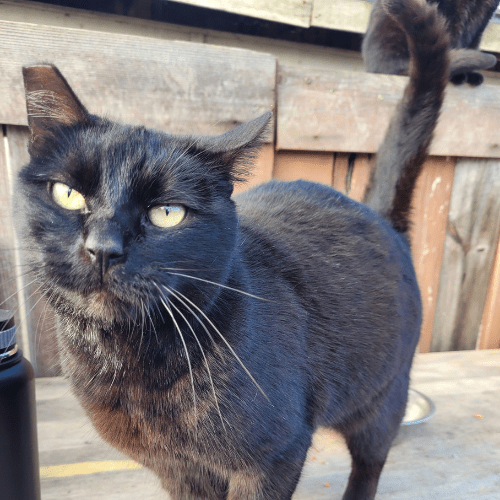
Navigating Life Without a Tail: Communication in Tailless Cats
In the fascinating world of cat tails, we mustn’t forget our tailless feline friends. So, how do tailless cats manage to communicate without their tails? They get creative! Tailless cats rely on:
- Body positioning
- Eye contact
- Ear movements
- Pheromones
To stay connected, even with a tail curled tightly, one doesn’t need a tail straight or an upright tail.
Most cats, whether tailless or not, have a remarkable ability to adapt and communicate their emotions. So, while we may not be able to have full-on conversations with our feline companions, understanding their unique ways of expressing themselves can surely strengthen our bond with these enigmatic creatures.
Petting Etiquette: Approaching Your Cat’s Tail Area
When it comes to petting your cat, there’s a certain etiquette to follow, especially when approaching the tail area. Focus your pampering on the chin and ears, as kitties are quite touchy when it comes to their tail region. Petting the tail area could lead to some not-so-friendly behavior, so it’s best to avoid it unless the cat is friendly with you.
On the other hand, some kitties love booty pets and will raise their butts when you pet them.
If your cat stops purring, swats or nips you, or tenses up when you get close to their tail, it’s a clear sign that they’re not digging the tail petting. Keep in mind that respecting your cat’s boundaries is key to fostering a loving and trusting relationship with your feline companion.
Summary
Understanding the secret language of cat tails can unlock a deeper connection with our feline friends. Each tail movement tells a story, from playful question marks to puffed-up tails signaling the need for space. We can forge stronger bonds with our whiskered companions and ensure their well-being by paying attention to these subtle signals and respecting our cats’ boundaries. So, hold your tail high, be a tail talk expert, and embrace the wonderful world of feline communication!
Cat Tail Language Frequently Asked Questions
What do cat tail movements mean?
Reading your cat’s tail is like learning a new language – a twitching or whipping tail can signal nervousness and aggression, while a straight-up tail with a hooked tip signals friendliness. Knowing your kitty’s cues will help keep both of you happy!
Why do cats flick their tails while lying down?
Cats sometimes wag or thump their tails while lying down. This is usually their way of showing that they feel comfortable and safe, even though they’re aware of your presence. It can also be their way of signaling that they are becoming overstimulated with petting or conversation.
Why does a cat swat its tail?
When cats swat their tails, they usually express emotions such as pleasure when greeting another cat, focus when watching something, playful anticipation during hunting, or irritation and annoyance when feeling stressed. Ultimately, cats use their tail to communicate with other cats and humans.
How do I know if my cat loves me?
You can tell if your cat loves you by looking for signs like slow blinking, head bunting, purring, cuddling, and showing you their belly. There are also tail positions like a question mark or when the cat may lay their tail on their human. These gestures of trust show that your cat is forming a strong bond with you.
How do tailless cats communicate?
Tailless cats communicate by relying on their body language, eye contact, ear movements, and pheromones – a clear testament to their keen awareness and sensitivity.
